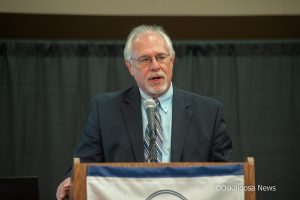Leader Speaks Series Showcases Journalism Importance For Our Society
Oskaloosa, Iowa – It’s no secret that journalism is going through a rough time. Advertising dollars are down for the traditional print, which means that there are fewer journalists covering the communities they serve.
Executive Director and Editor of the Iowa Center for Public Affairs, Lyle Muller, gave a presentation this past week at the Musco Technology Center on the Campus of William Penn University. His presentation was titled, “Who’s Watching Out For You, And The Changing Face Of Journalism”.
Muller spoke about the function of the press and the importance they play by being the watchdog in the public’s interest.
According to Gallup, journalists have ranked in the mid-20% range for trustworthiness by the public – a number that once was as high as 33% back in 1976.
That trend started in the postmodern era, as the United States exited the Vietnam war, and the public began to lose its general trust in the institutions.
In an era of social media, the question often falls regarding how to get the populace to engage with journalists and the news. “It’s a worldwide issue,” said Muller.
Muller showcased how news delivery has evolved over time, which had town criers, through to pamphlets and leaflets, and eventually to radio and television. Muller remembers watching Edwin R. Murrow on CBS. “He was the face of everything good in journalism in the 1950’s.”
Social media sites, like Twitter, help news consumers stay informed about breaking news, and users like Luller start their day working their way through those feeds to find out what the news from overnight is.
This happens before he picks up his traditional print paper, whom he was a part of for several years. “The newspaper has been good to me. I spent a long time in newspapers. 33 years in fact”, added Muller.
Muller spent 25 of those 33 years at the Cedar Rapids Gazette, where he retired as the Executive Editor.
“We are always getting our news and information from what is in our hand, or the handiest for us,” said Muller.
According to Pew Research Center for 2016, 57% of news consumers get their information from television, while 38% get their news from digital sources. The research show that 28% of those consumers get their news from radio, while 20% get their info from print newspapers.
Local television news is down 7% over the past year, yet their revenue continues to go up.
Newspapers have seen their revenue drop 8% from 2014 to 2015. That revenue should increase for 2016, as political advertising dollars find their way back to those stations.
With those loss of numbers to print media, advertisers begin to look elsewhere to spend their dollars. That loss of revenue equates to fewer reporters, which can then impact the community as there are less resources to perform vital functions like investigative reporting.
According to the 2015 newsroom census performed by ASNE, there were 32,900 full-time and part time journalists located in 1,400 daily newspapers. Those individuals are reporters, photographers and editors.
That number is down 3,800 reporters from the year before.
In the 1997 survey, there were 55,000 journalists active in newspaper offices around the country.
With approximately 40% fewer journalists, it becomes more difficult to keep communities informed.
Investigative and watchdog journalism is something that has suffered due to newsroom cutbacks.
The amount of resources necessary to conduct investigative journalism can be costly for a news department that is struggling to make ends meet.
With that being said, there does continue to be great investigative reporting that is taking place, and this week, the Omaha World Herald put the spotlight on a local charity that serves portions of Nebraska and Iowa.
Their investigative reporting lead to the resignation of the charity’s CEO due to the reporting by the paper.
Other great investigative pieces have been completed by the Des Moines Register, Burlington Hawkeye and others.
According to Muller, in 2010 more people than ever were watching the news, but were drifting to ideological news outlets.
Today, news aggregator sites like Yahoo News, Google News and social media help individuals find news. Aggregators like Yahoo and Google are taking stuff for free and placing it on a website without vetting the information, or helping offset the cost of producing the product.
Today, direct information is also available to news consumers. Candidates can offer up their information directly to individuals, without information being scrutinized for accuracy.
“Hillary Clinton and Donald Trump do not need news organizations, they can reach us directly”, said Muller.
That same process is taking place every day from the White House to city halls across the state and country.
Today, we have more choices and opportunities than ever before to find information. The question to be answered, is what role the press will play in the future, to help preserve their presence at the ‘Fourth Estate’.













